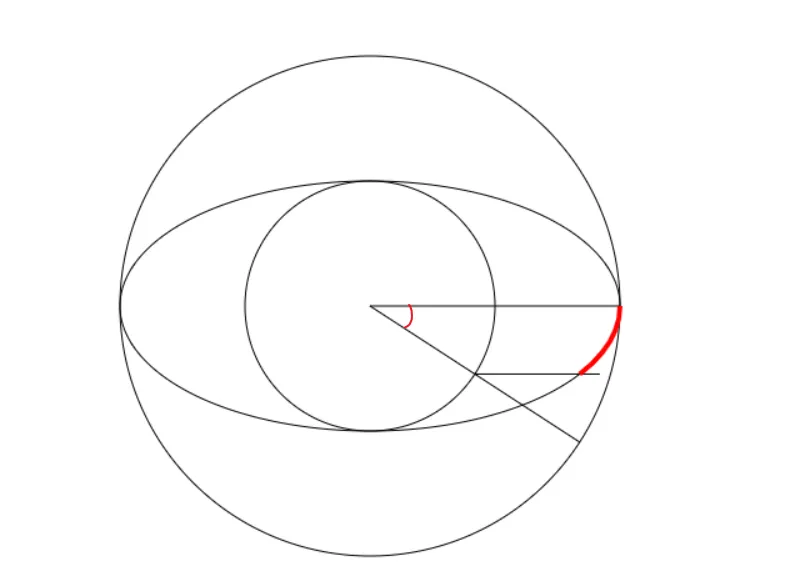var c = document.getElementById("canvas");
var ctx = c.getContext("2d");
var startAngle = Math.PI * 2 / 360 * 75;
var endAngle = Math.PI * 2 / 360 * 345;
ctx.fillStyle = "rgba(255, 255, 255, 0.125)";
function correctEllipse(ctx, cx, cy, w, h, r, sa, ea) {
sa = Math.atan(w/h * Math.tan(sa))
ea = Math.atan(w/h * Math.tan(ea))
ctx.ellipse(cx, cy, w, h, r, sa, ea);
}
w = 50
h = 50
ctx.beginPath();
ctx.moveTo(70, 150);
correctEllipse(ctx, 70, 150, w, h, 0, startAngle, endAngle);
ctx.lineTo(70, 150);
ctx.stroke();
ctx.fill();
h = 60
ctx.beginPath();
ctx.moveTo(70, 150);
correctEllipse(ctx, 70, 150, w, h, 0, startAngle, endAngle);
ctx.lineTo(70, 150);
ctx.stroke();
ctx.fill();
h = 70
ctx.beginPath();
ctx.moveTo(70, 150);
correctEllipse(ctx, 70, 150, w, h, 0, startAngle, endAngle);
ctx.lineTo(70, 150);
ctx.stroke();
ctx.fill();
h = 80
ctx.beginPath();
ctx.moveTo(70, 150);
correctEllipse(ctx, 70, 150, w, h, 0, startAngle, endAngle);
ctx.lineTo(70, 150);
ctx.stroke();
ctx.fill();
h = 90
ctx.beginPath();
ctx.moveTo(70, 150);
correctEllipse(ctx, 70, 150, w, h, 0, startAngle, endAngle);
ctx.lineTo(70, 150);
ctx.stroke();
ctx.fill();
h = 100
ctx.beginPath();
ctx.moveTo(70, 150);
correctEllipse(ctx, 70, 150, w, h, 0, startAngle, endAngle);
ctx.lineTo(70, 150);
ctx.stroke();
ctx.fill();
h = 110
ctx.beginPath();
ctx.moveTo(70, 150);
correctEllipse(ctx, 70, 150, w, h, 0, startAngle, endAngle);
ctx.lineTo(70, 150);
ctx.stroke();
ctx.fill();
h = 120
ctx.beginPath();
ctx.moveTo(70, 150);
correctEllipse(ctx, 70, 150, w, h, 0, startAngle, endAngle);
ctx.lineTo(70, 150);
ctx.stroke();
ctx.fill();
h = 130
ctx.beginPath();
ctx.moveTo(70, 150);
correctEllipse(ctx, 70, 150, w, h, 0, startAngle, endAngle);
ctx.lineTo(70, 150);
ctx.stroke();
ctx.fill();
h = 140
ctx.beginPath();
ctx.moveTo(70, 150);
correctEllipse(ctx, 70, 150, w, h, 0, startAngle, endAngle);
ctx.lineTo(70, 150);
ctx.stroke();
ctx.fill();
h = 50
w = 50
ctx.beginPath();
ctx.moveTo(300, 150);
correctEllipse(ctx, 300, 150, w, h, 0, startAngle, endAngle);
ctx.lineTo(300, 150);
ctx.stroke();
ctx.fill();
w = 60
ctx.beginPath();
ctx.moveTo(300, 150);
correctEllipse(ctx, 300, 150, w, h, 0, startAngle, endAngle);
ctx.lineTo(300, 150);
ctx.stroke();
ctx.fill();
w = 70
ctx.beginPath();
ctx.moveTo(300, 150);
correctEllipse(ctx, 300, 150, w, h, 0, startAngle, endAngle);
ctx.lineTo(300, 150);
ctx.stroke();
ctx.fill();
w = 80
ctx.beginPath();
ctx.moveTo(300, 150);
correctEllipse(ctx, 300, 150, w, h, 0, startAngle, endAngle);
ctx.lineTo(300, 150);
ctx.stroke();
ctx.fill();
w = 90
ctx.beginPath();
ctx.moveTo(300, 150);
correctEllipse(ctx, 300, 150, w, h, 0, startAngle, endAngle);
ctx.lineTo(300, 150);
ctx.stroke();
ctx.fill();
w = 100
ctx.beginPath();
ctx.moveTo(300, 150);
correctEllipse(ctx, 300, 150, w, h, 0, startAngle, endAngle);
ctx.lineTo(300, 150);
ctx.stroke();
ctx.fill();
w = 110
ctx.beginPath();
ctx.moveTo(300, 150);
correctEllipse(ctx, 300, 150, w, h, 0, startAngle, endAngle);
ctx.lineTo(300, 150);
ctx.stroke();
ctx.fill();
w = 120
ctx.beginPath();
ctx.moveTo(300, 150);
correctEllipse(ctx, 300, 150, w, h, 0, startAngle, endAngle);
ctx.lineTo(300, 150);
ctx.stroke();
ctx.fill();
w = 130
ctx.beginPath();
ctx.moveTo(300, 150);
correctEllipse(ctx, 300, 150, w, h, 0, startAngle, endAngle);
ctx.lineTo(300, 150);
ctx.stroke();
ctx.fill();
w = 140
ctx.beginPath();
ctx.moveTo(300, 150);
correctEllipse(ctx, 300, 150, w, h, 0, startAngle, endAngle);
ctx.lineTo(300, 150);
ctx.stroke();
<html>
<body>
<canvas id="canvas" width="500" height="300">
</body>
</html>
